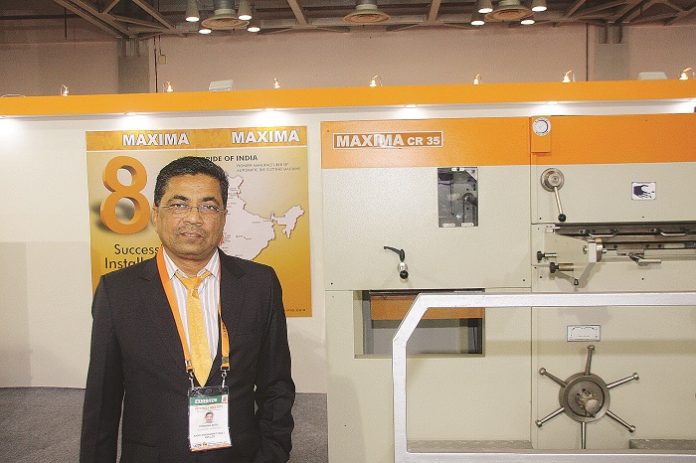
Ahmedabad-based Excel Machinery has traditionally been a manufacturer of autoplaten diecutting (punching) machines for monocarton printers and converters providing paperboard packaging for the pharmaceutical, cosmetics, food, beverages industries amongst others. However, at Printpack 2015, Excel has introduced the Maxima CR 35 which is a semi-automatic corrugated paper diecutting machine targeted at the mid- and large-sized corrugated companies with a maximum sheet size of 35 x 24.75 inches and speed of 4,000 sheets an hour.
Jitendra Patel, managing director of Excel Machinery says, When any customer opts for any Maxima range of machines, we provide full training to their operators and extend our assistance for any kind of help they expect from us. We are engaged with the pharmaceutical, cosmetics, food and beverages industry in India and many of our customers have more than one machine which I think is a testament to the quality and value we provide to them. Till date Excel has already sold and installed 86 Maxima diecutters to customers in India.
Excel is also continuously upgrading its diecutters with better technology for increasing precision and speed. Excel plans to come up with a 28 x 40-inch diecutting machine with a speed of 7,500 sheets an hour in the next six to seven months. To manufacture this upcoming machine and also to further upgrade the general quality of its machines, Excel has imported CNC-VNC tooling machines from Germany and constructed a new assembly site within its premises.
In terms of competition Patel says there is no other Indian manufacturer which is manufacturing diecutting machines. He also feels that international companies like Bobst belong to a completely different category. There are the Chinese also as Patel explains that there are more than 30 Chinese diecutting manufacturers who are eyeing the Indian market. Notwithstanding the steady flow of Chinese machines to India, Patel believes that Excels diecutters will continue to be bought by discerning converters who appreciate their quality and the local back up provided by a strong Indian manufacturer.
Excel Machinery has been growing consistently over the last few years and is achieving a growth of 30% on an year-to-year basis says Patel. In the next financial year, the company intends to install at least 25 to 30 machines. We take pride in the patronage of our customers and believe this provides us a constant motivation to make our machines even better. Excel believes in ease of use, excellent quality of the end products and affordability for its customers. I even believe that Indian companies should try and strive to be a manufacturer first instead of supplying for foreign companies which will provide a tremendous boost to the countrys economy in the long-term, concludes Patel.










